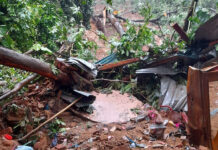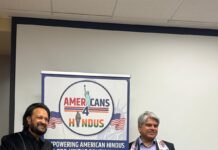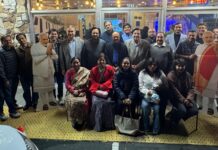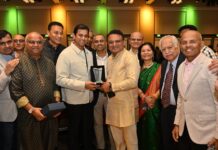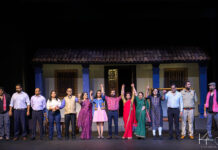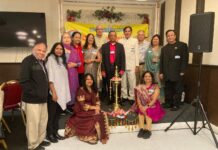
musical talent by master-musicians from India
CHICAGO: The annual Chicago Tyagaraja Utsavam (CTU), the three-day ‘festival’ celebrated here at the Hindu Temple of Greater Chicago over the Memorial Day weekend saw budding local talent as well as several new faces from India.
CTU’s prime goal is to popularize the compositions of the saintly musician-composer Tyagaraja among the growing children of Indian origin. It is made possible through monthly group rehearsals conducted by many dedicated teachers from the western and northern suburbs of Chicago.
The classical Carnatic vocal compositions (kriti) of Tyagaraja, who lived in the late 18th C. and early 19th C. in Tiruvayyaru in present day Tanjore district in Tamil Nadu, are considered to be among the finest in Carnatic music.
Tyagaraja’s five gems (pancha-ratnam); group offerings by aspiring elder musicians (pragata samarpanam); singing of divine names (divya-naama-sankeertanam) meant for special occasions at temples and homes during marriages and festivals; “Bhaavayaami Raghu-Raamam” (“I contemplate Rama of the Raghu clan”) introducing its composer Maharaja Swati Tirunal of Kerala to a special forum for music students from northern suburbs; and musical praise (abhivandanam) of Lord Rama and Hanuman – they were are all parts of this year’s festival.
The Pancharatna, which are always sung at Tyagaraja festivals everywhere, are set to five (ghana) ragas – Nata, Gaula, Aarabhi, Varaali and Shree – which lend themselves to elaborate improvisation and to veena-playing.
Four specially trained students from Surya Prakash’s residential learning center (guru-kulam) gave a sample ragam-taanam-pallavi (RTP) in ragams Vasantha and Amrutavarshini, effecting the transition purely through a judicious modal shift. Kamala Kiran on violin and Vinod Seetaraman on mridangam skillfully managed the modal shift requirements. Prakash’s workshop sampled the vocal styles of Madurai Mani Iyer and the latter’s guru Madurai Pushpavanam.
The distinctive culture of Kerala state was highlighted through its traditional temple orchestra (pancha-vaadyam) comprising four drums and a wind instrument (kombu), fanfare on the cylindrical wooden drum (chenda melam) and group folk dance (kaikottikali), as preamble to the yearly morning procession. Guest vocalist from India, Serthalai Ranganatha Sharma, topped this celebration of Kerala by demonstrating the voice culture of its Carnatic musicians. The homage to Tyagaraja concluded with a group rendering of Geetaarthamu in Suruti ragam.
The second day concluded with a violin recital by Padma Sri Kanyakumari from India with her brilliant student from the East Coast Kamalakiran Vinjiamuri, accompanied by Trivandrum Balaji on mridangam and K.V. Gopala Krishnan on kanjeera (tambourine). Her astounding speed, creative rendition of Annamacharya’s composition “mElu lEdu tElu lEdu” in the novel ragam Naaraayanaadri, subtle delineation of ragam Hari Kamboji and expansive rendering of “Kalikiyunte” in Keeravani, all constituted a musical feast.
Other highlights were “Rama’s childhood” (baala-kaandam) through dance-drama choreographed to Tyagaraja kritis by Hema Rajagopalan, musical discourse (hari-katha) by Subbaraman and Selvi Alamelu on Oothukkadu Venkata Kavi’s originality as composer, and Bharat Sunder’s mastery of over the ragam Bhairavi.
Prof T.E.S. Raghavan


